Latest news about Bitcoin and all cryptocurrencies. Your daily crypto news habit.
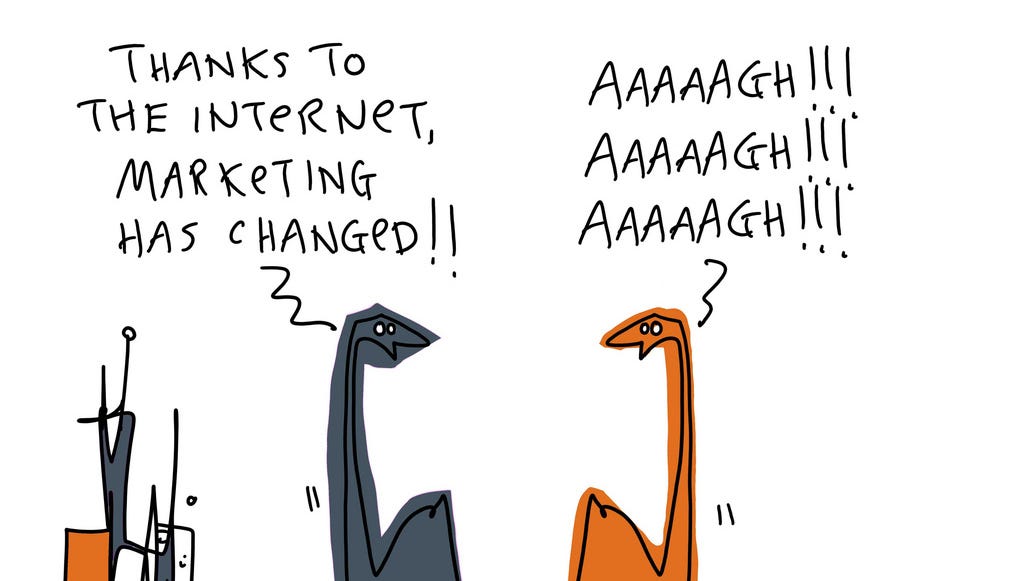 Art credit to Hugh MacLeod’s work on the HubSpot blog
Art credit to Hugh MacLeod’s work on the HubSpot blog
In my opinion, understanding what our funnel looks like — or what we want it to look like — is the core context for all the actual work of marketing.
There is a bit of the chicken and egg about it, as any funnel will co-evolve with where we have sales success (or failure) and it will also co-evolve with the core components of the product and messaging — things like: who the user is, who the buyer is, what the value prop is, what the differentiation is.
The funnel exists within the context of some go to market (GTM).
Programming notes: this post is n in a series of indeterminate length on GTM topics mainly for startup people, mainly leadership, mainly coming from non-GTM backgrounds. There’s a list at the end.
GTM
Literally, how we go to the market. We have a thing that we want to trade. We need to…
- Decide who it’s for
- Find the market(s) that has those people
- Figure out how they will know we exist and are in the market
- Get them to stop by our stall
- Convince them of the value
- Get them to try it or buy it
- Price the thing such that we make some money (staying in business is good) and such that customers feel like they’re getting they’re money’s worth
- Decide if there will be haggling
- Decide if customers who pay more get more, different, or better things and/or service
- Package the thing(s) in a way that’s appealing and easy to understand and maybe easy to compare.. or not (with intent)
- Figure out how to do the sale, like with someone who’s job it is to sell or maybe customers just put money into a box and take the right amount
- Actually do the sale, ask for the money, take the money, hand over the product
- Figure out how to get customers to come back for more
- Learn the things that make for satisfied, or dissatisfied, customers
- Find the next market and the next customers
The Funnel
This is how GTM people — sales & marketing (& “growth”) — model the process of customer acquisition from the “top” (awareness) to the “bottom” (paying customer).
Note that in recurring revenue, subscription services the bottom might be further down at retention/renewal.
In other kinds of businesses, what you have may not be a funnel at all, but rather a flywheel or something else. [Hint: It’s still a funnel.] There are as many models as there are pundits. Every single one is wrong and also useful. We have to find the one that works best for our specific business competing in its specific market for its specific customer base and its specific state of maturity and development.
Examples!
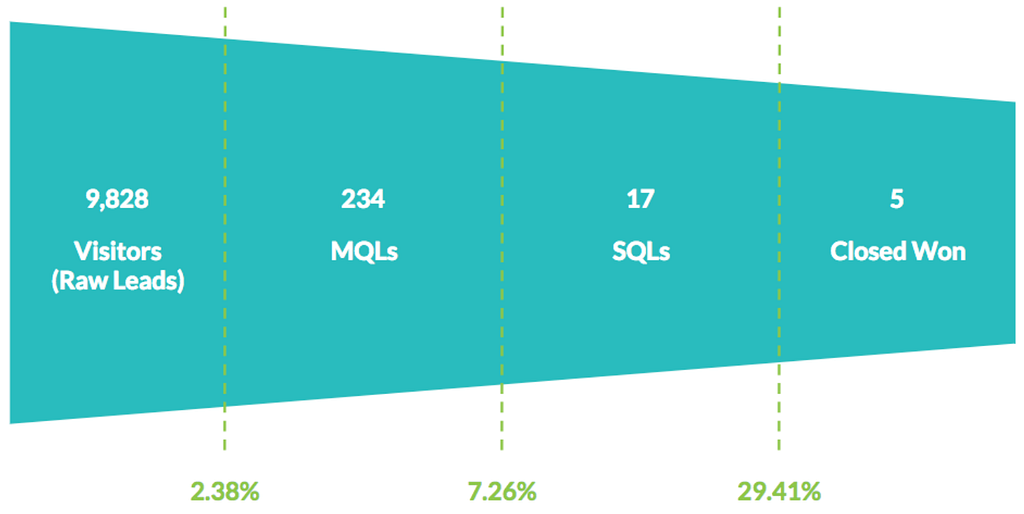 SImple Funnel
SImple Funnel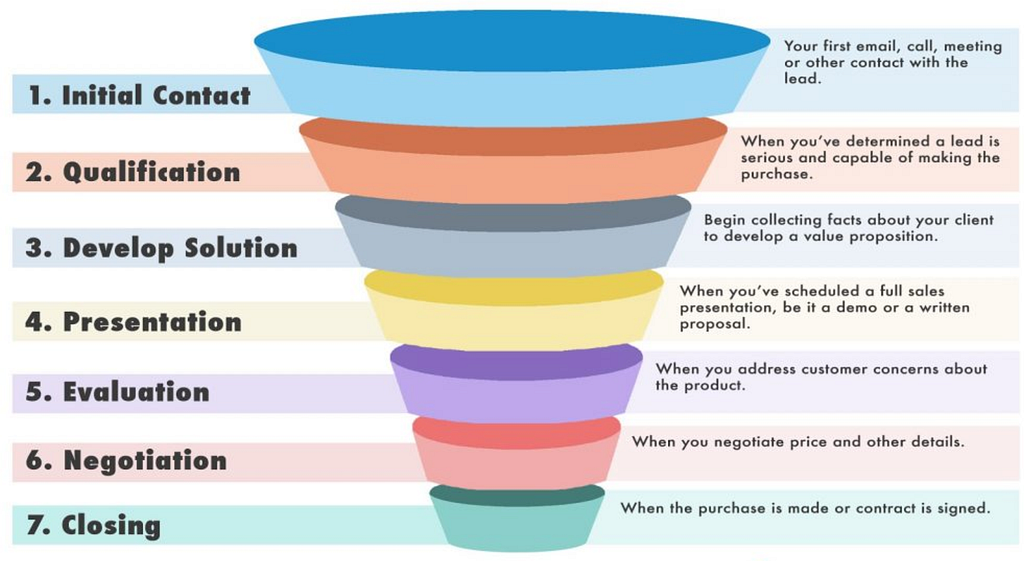 Outbound Sales-Led Funnel
Outbound Sales-Led Funnel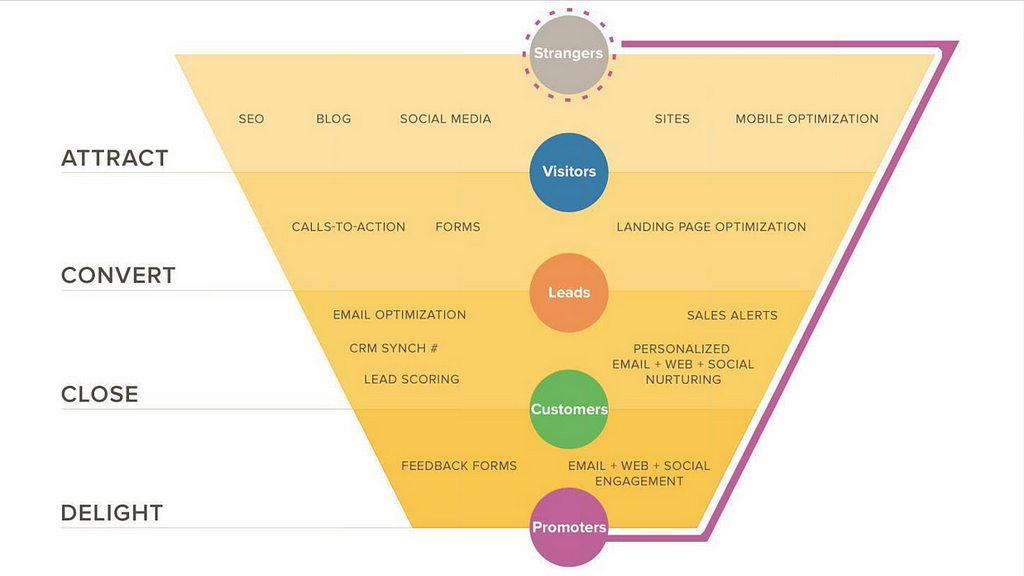 Inbound Self-Service Funnel
Inbound Self-Service Funnel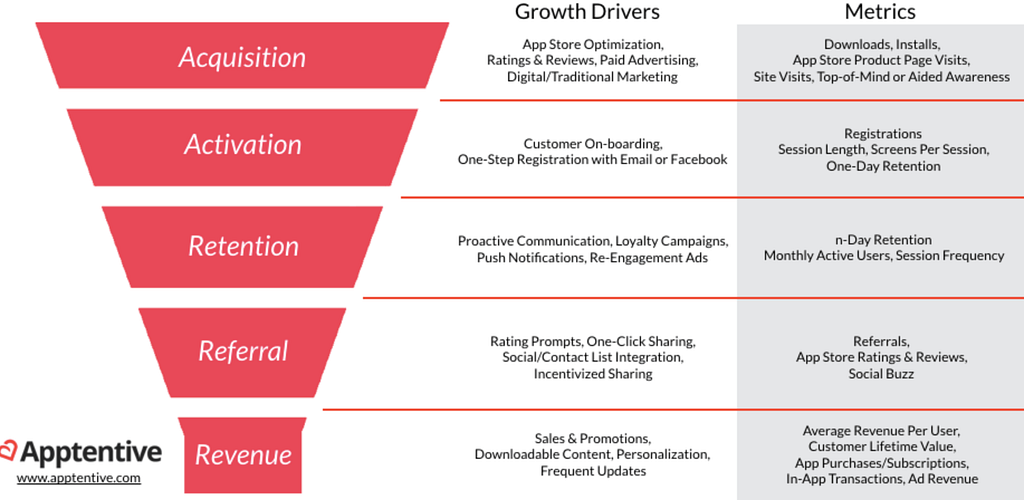 AARRR Funnel
AARRR Funnel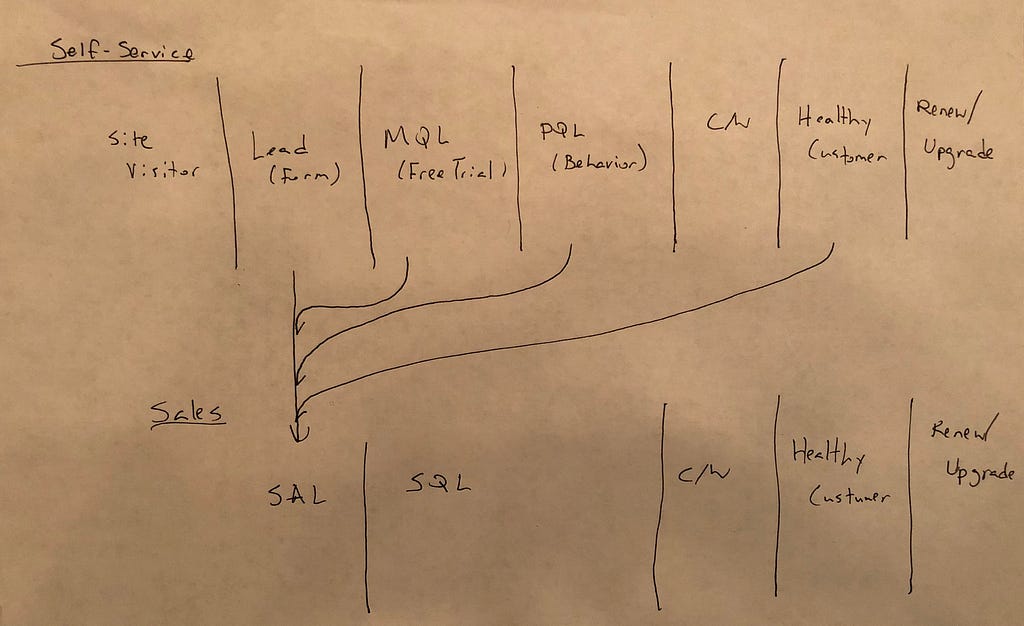 Inbound Self-Service + Inbound Sales Funnel [Yes, I drew that.. sorry]
Inbound Self-Service + Inbound Sales Funnel [Yes, I drew that.. sorry]
The exact terminology we use for each stage doesn’t matter too much, as long as everyone knows what we’re talking about. As we scale, we’ll get driven towards common language used in the industry.
If we zoom in to a particular stage, there are plenty of substages. Sales teams, especially, have their own sub-funnel that they work against that specifies sales qualification and opportunity development stages and comes with its own terminology. This is generally not reflected in top-level funnel views. But, it is used by sales leaders (along with compensation and playbooks) to understand and tune the performance of the sales organization.
To be really effective at marketing, we should understand exactly how the sales team operates so we can tune upstream activities and diagnose failure modes.
Advice
- Reject models that do not work mercilessly
- Customize the ones that do to fit
- Measure frequently and consistently
- Take confirmatory evidence lightly
- Take disconfirmatory evidence.. heavily
- Have ideas about the next models that might work before the one you’re using now stops working
Metrics
Here’s what we have to measure to have any idea of what’s going on:
- Absolute numbers of people in each stage
- Conversion rates from each stage to the next
- The change in those metrics week over week (WoW), month over month (MoM), quarter over quarter (QoQ), and year over year (YoY)
Generally speaking, you would expect that the numbers go down as people move through the funnel. [That’s why it’s a funnel!] In order to actually see this, we need some minimal viable cohort to measure. That is usually done on a time boundary. Weekly and monthly are common for campaigns, tactics, and day-to-day operation of the marketing function. Monthly, quarterly, and yearly are typical for reporting and board meetings.
But we might also run special cohorts for testing (A/B or otherwise) campaigns, tactics, and assets that are on much shorter time boundaries.. or even just something like “the 100 site visitors who were sent to this landing page”.
In addition to the above, we should look for proxies to the upstream quality-of-leads-generated and revenue-mechanics:
- Conversion rates between: MQL -> C/W and MQL -> Churn
- Pipeline per MQL
- Cost Per (unqualified) Lead (CPL) and/or CPMQL
- Actual revenue per Unqualified Lead and/or MQL
- MQL -> disqualified-by-Sales or DQ-by-self for self-service funnels
And [counter]indicators that can factor into our evaluation of both our chosen GTM and our sales motion:
- Average Selling Price (ASP)
- Annual Contract Value (ACV)
- Sales Cycle
- Conversion rate from Sales Qualified Lead (SQL) -> C/W
- Ratio of ASP to Pipeline per SQL
Measurement
I am not a proponent of magic metrics. In my experience, single-metric optimization blinds us to evidence that will tell us that some part of our GTM isn’t working (or losing efficacy, which is normal)… until very late in the game.
Advice
- Measure as much as you can
- Do it consistently on a fixed schedule
- Be explicit about assumptions and methodology
- Report much less than you collect
Things to watch out for:
- Confusing sales effectiveness for anything that is not controlled by sales effectiveness — sales development reps (SDRs) getting better at qualification and account execs (AEs) getting better at forecasting revenue-per-deal is not a function of more/better leads
- A change in any upstream metric that does not result in changes in downstream metrics in the same direction — if this happens, figure out where the propagation stops and solve from there OR realize that the change in the upstream metric was a failure/bullshit
- A change in any downstream metric that happens independent of upstream metrics — if this happens unintentionally, figure out how and scale (if positive) or stop the bleeding (if negative)
Levers
The way we model and measure the funnel should tell us how to improve it.
Let’s sketch out a very simple example:
If we have a five stage funnel with 10000 leads a month coming in the top and 10% conversion rates between each stage with a 30 day sales cycle, then for each cohort starting at day 0 and ending at day 30 we only end up with 1 paying customer [10000 → 1000 → 100 → 10 → 1].
How do we think about improving this funnel?
There is only one goal: increase the numbers.
There are only two ways to do that: more volume or higher conversion.
More volume at the top should result in more customers at the bottom. If it doesn’t, we have a capacity or efficacy or execution problem somewhere below.
A better conversion rate at any stage should result in more volume at the next stage, which should result in more customers at the bottom. If it doesn’t, we have a capacity or efficacy or execution problem somewhere below.
So, either we do things to increase volume or we do things to increase a particular conversion rate.
If we can’t break down even the most complicated funnel or flywheel or whatever to these levers — we’ve lost our way and should reconsider this whole building a business thing. :)
Things Left Out
The lifecycle of a lead, or customer, includes more than is described in a typical funnel. We should have develop a complete model for that lifecycle, even if it’s not reported on regularly or shown in a funnel diagram.
Example!
If a lead does not become a customer, they are Closed/Lost (C/L). There are reasons for that which would typically be recorded in some way in a CRM or marketing automation platform. Many of those reasons will be… reasonable: bad time, interested but no budget, love it but just bought something else.
In that case, those leads should enter a stage that’s not shown on a typical funnel called “remarket” or “delay lead nurture” or something. This is a long running stage that sits between MQL and whatever comes next where we’ll stay in touch with that lead until they are ready, or conditions change, or they move on to their next company and give us a shot there.
Example!
For subscription businesses, post-becoming-customer is also a funnel that tracks customer-to-churn stages which we might want to look at separately as part of the operation of a Customer Success function.
Informal Definitions and Explanations
These are taken from the Sales 101
- Suspect: someone who arrives on your website or you encounter in the course of marketing/selling, like at a booth at a conference
- Prospect: someone who might possibly have some interest in buying.
- Lead: someone who might definitely have some interesting in buying (note the increase in probability).
- Raw Lead: An unqualified Lead, i.e. Suspect or Prospect
- Qualification: The act of progressively determining the likelihood of a given Prospect/Lead being willing, able, and likely to buy
- Disqualification: The act of determining that a given Prospect/Lead is not willing, able, and likely to buy
- Marketing Qualified Lead (MQL): someone who might definitely have some interest in buying and is also from the right kind of organization, or has the right title, or has demonstrated active interest by doing something like looking at the docs and clicking around the pricing page and filing out a form, etc. MQLs is a common metric used to measure the efficacy of demand gen activities run by the marketing team (“programs, campaigns, tactics”).
- Product Qualified Lead (PQL): In the world of self-service sales, someone who becomes qualified through their behavior in interacting with the product during a free trial, in the freemium version, or even after becoming a customer in whatever tier they’re in (e.g. “PQL-ed for an upgrade offer”).
- Sales Accepted Lead (SAL): MQLs that have been validated as having sufficient probability to buy to be actively worked on by a sales rep — SAL qualification is a point of contention between marketing and sales teams regarding the quality of leads being brought in by marketing activities and the rigor of the process used by sales orgs to validate them.
- Sales Qualified Lead (SQL): SALs that have been qualified to the extent of the rep being able to say with surity that the lead has a problem that the product solves, the desire to solve that problem, and the budgetary/authority means to do it by buying the product — SQL qualification can be a point of contention within a sales team and frequently very strict, formal definitions are used (and ignored).
- Opportunity (Opp or Op): some level of qualification beyond SAL and possibly beyond SQL — opportunities are generally broken up into stages, e.g. “Stage 2 Opportunity”, which are related to the formal definitions of lead types, e.g. SQL == Stage 2 Opportunity.
- Disqualify (DQ): state that a lead is unqualified.
- Annual Contract Value (ACV): Exactly what it sounds like
- Average Selling Price (ASP): Exactly what it sounds like
- Sales Cycle: the amount of time it takes to close a deal from when it enters the pipeline.
- Sales Efficiency: inverse of Payback Period, a measure of how effective sales (and marketing) are at generating revenue.
- Pipeline: the $ of all the deals forecasted at any level fo the sales org — i.e. each rep has a pipeline, but so does their team, and so does the entire sales org.
- Proof of Concept (POC) [aka Trial]: trial period, sometimes paid for by the prospective customer (Paid POC). POCs are often long or especially customized for the account. Usually involves the account using the product in real life for a specific use case and committing to any associated integration work. These are typically intended to have well defined outcomes and commitments. Paid POCs are frequently marketed as “customers” by startups, what I would call “standard bullshit”.
Posts in this series
- Marketing 101 for Engineers
- Marketing 102 for Engineers
- Sales 101 for Engineers
- PR 101 for Engineers
- Analyst Relations 101 for Engineers
Reading List
- Bob Tinker’s GTM Fit Talk and Slides
- Tomasz Tunguz’s Blog (the image at the top comes from there)
- Tren Griffin’s Blog
- Growth Hackers Community
- Kissmetrics’ Blog
- HubSpot’s Blog
- Optimizely’s Blog
- Reify’s Blog
- Startups ❤ Customers
- Startup Marketing Playbook
Marketing 102 for Engineers was originally published in Hacker Noon on Medium, where people are continuing the conversation by highlighting and responding to this story.
Disclaimer
The views and opinions expressed in this article are solely those of the authors and do not reflect the views of Bitcoin Insider. Every investment and trading move involves risk - this is especially true for cryptocurrencies given their volatility. We strongly advise our readers to conduct their own research when making a decision.
